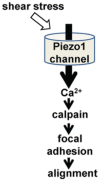The Rheology of the Carotid Sinus: A Path Toward Bioinspired Intervention
- PMID: 34178967
- PMCID: PMC8222608
- DOI: 10.3389/fbioe.2021.678048
The Rheology of the Carotid Sinus: A Path Toward Bioinspired Intervention
Abstract
The association between blood viscosity and pathological conditions involving a number of organ systems is well known. However, how the body measures and maintains appropriate blood viscosity is not well-described. The literature endorsing the function of the carotid sinus as a site of baroreception can be traced back to some of the earliest descriptions of digital pressure on the neck producing a drop in blood delivery to the brain. For the last 30 years, improved computational fluid dynamic (CFD) simulations of blood flow within the carotid sinus have demonstrated a more nuanced understanding of the changes in the region as it relates to changes in conventional metrics of cardiovascular function, including blood pressure. We suggest that the unique flow patterns within the carotid sinus may make it an ideal site to transduce flow data that can, in turn, enable real-time measurement of blood viscosity. The recent characterization of the PIEZO receptor family in the sinus vessel wall may provide a biological basis for this characterization. When coupled with other biomarkers of cardiovascular performance and descriptions of the blood rheology unique to the sinus region, this represents a novel venue for bioinspired design that may enable end-users to manipulate and optimize blood flow.
Keywords: PIEZO receptor; baroreceptor; blood flow; carotid sinus; viscosity.
Copyright © 2021 Iskander, Bilgi, Naftalovich, Hacihaliloglu, Berkman, Naftalovich and Pahlevan.
Conflict of interest statement
The authors declare that the research was conducted in the absence of any commercial or financial relationships that could be construed as a potential conflict of interest.
Figures





References
-
- Andani R., Khan Y. S. (2020). “Anatomy, head and neck, carotid sinus,” in StatPearls, (Treasure Island, FL: StatPearls Publishing; ). - PubMed
Publication types
LinkOut - more resources
Full Text Sources
Miscellaneous

